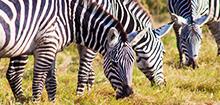
Date Published:
Hundreds of Kenyans joined the rest of the world to mark Global March For Elephants, Rhinos and Lions (GMFERL), which is celebrated on October 7, every year.
The processional march was flagged off by the Cabinet Secretary, Ministry of Environment and Natural Resources, Prof. Judi Wakhungu at the National Museums of Kenya, and snaked through Uhuru Highway and Langata Road, to KWS headquarters in Nairobi, led by KWS band.
GMFERL is a worldwide call to action to condemn the poaching of elephants, rhinos and lions and the trafficking of wildlife trophies. The march also aims at rallying countries and their citizens against trafficking of wildlife trophies.
This global movement calls upon governments, the civil society, grassroots communities and all stakeholders to be proactive with a view to guaranteeing the survival of elephants, rhinos, and lions.
It exhorts governments, the civil society, grassroots communities and other stakeholders to be proactive and synergetic to ensure the survival of elephants, rhinos and lions.
In their millions of years on earth, elephants, rhinos and lions have seldom encountered such a catastrophe as the poaching scourge. A century ago, African savannahs played host to sprawling populations of millions of elephants, rhinos and lions.
These majestic land mammals are losing the battle for survival because of the greed motivating illegal wildlife products trade worth billions of dollars. It is estimated that 100 elephants are massacred for their tusks in Africa on a daily basis. The dwindling numbers of the elephant population emanates from poaching at an industrial scale.
Today poaching is being executed using sophisticated means such as automatic weapons, helicopter gunships, and night-vision equipment. Ivory trade is also increasingly being run by transnational criminal networks, while profits from the ‘blood ivory’ trade are used to help fund terrorist networks.
Other threats facing the elephants are habitat loss, degradation and ever-increasing human-elephant conflict. As human populations continue to grow across elephants’ traditional range, more and more land is being taken over for agriculture and pastoralism.
The future of these keystone species teeters on the knife edge of extinction because of burgeoning human population and infrastructural expansion, as well as the spike in demand for ivory and rhino horn in the Asian markets.
The sale of ivory and rhino horns is supremely remunerative and therefore terrorist groups are now in the business of poaching so as to finance their activities; especially in Central Africa, and more recently, Eastern Africa.
In September 2013, the then American Secretary of State Hillary Clinton drew a direct link between terrorism and elephant poaching, citing emerging evidence that terrorist groups in Africa are funding their activities in part by trafficking ivory.
“It is disheartening that approximately three rhinos are slaughtered daily for their horn. Since 2008, poachers have killed at least 5,940 African rhinos”, said Prof. wakhungu in a speech read on her behalf by the principal Secretary in the ministry, Dr. Margaret Mwakima.
The acting Director General of KWS Mr. Julius Kimani while addressing the Global march participants, stressed on the need to snuff out poaching, saying that the elephant population in Kenya is estimated at 38,000 individuals, with escalating threats from habitat loss and degradation and ever increasing human-wildlife conflict aside from poaching. He lamented that daily; roughly 100 elephants in Africa are brutally killed for their tusks.
He said the latest KWS records indicate that there are approximately 2,000 lions in Kenya as human-wildlife conflict triggers communities adjacent to lion sanctuaries to poison and kill them.





